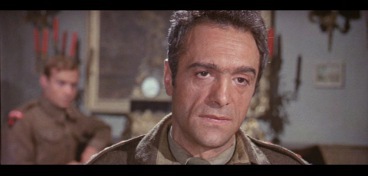


France, 1940 - the Allied armies are in full retreat in the face of overwhelming German advances. A small British squad are ambushed in the woods and killed by German soldiers in British uniforms who steal their ID tags. Disguised as British soldiers, the German spies join up with the Allied troops being rescued from the beaches at Dunkirk and later regroup in London where they set-about trying to find and disrupt the British radar equipment - a vital tool in preventing the German air attacks which are building in intensity in the run up to the planned invasion. Meanwhile Captain Paul Stevens (Frederick Stafford) suspects that some German soldiers may have passed into the country undetected in the chaos and sets up a task-force to try and catch them, not knowing that his new friend 'Martin Donovan' is actually one of the spies...

|

|
The 1960s saw a great boom in Second World War films in both Britain and Hollywood as the war movie evolved from small scale black and white drama to grand colourful epic. At the same time Italian exploitation producers, in the gaps between shooting endless streams of Spaghetti Westerns, looked to cash in on the popularity of these films with their own selection of war films - although most were low budget productions on a small scale, Eagles Over London was a highly audacious attempt to mimic one of the grandest 1960s war films, Battle of Britain (1969).
Eagles Over London certainly tries its best - the opening Dunkirk sequences and the background scenes in the radar stations are all pretty well done, unfortunately the main plot thread itself is simply nonsense, with glaring logical gaps from the very start. The whole idea of the German troops merely stealing dog tags off corpses to pass as British soldiers and then relying on getting picked up from the beaches (with no-one recognising them) and allowed to freely meet up in London with no orders to return to their units or homes seems highly tenuous. Logical flaws and historical inaccuracies abound through the rest of the picture - none of the writers seem to have read any history books about the progress of the Battle of Britain (attacks on London seem to come much too soon, no reference made at all to real RAF tactics and the Luftwaffe seem to switch from night to day raids, rather than the other way around, seemingly making their biggest push in mid-October when the real battle had all but finished) and the mistakes come down to the most ridiculous detail (a radar operator warns of German planes flying North-North-East from Calais to attack London...).
Even ignoring these historical problems though, the film quickly becomes bogged down in, what even Castellari himself described as, soap opera plotting. Although Battle of Britain similarly wasted a lot of time on its coy romantic subplot and Eagles seems determined to copy the Christopher Plummer/Susannah York romance, even down to the lovemaking in a hotel during a bomb raid, the British film did at least build character and the patience was repaid with dramatic airborne action scenes - Eagles never builds much in terms of character with the romantic subplot being nothing more than a loose, generic plot thread. More slavish copying comes in the unnecessary portrayal of a group of French airmen who want to fly for the RAF who seem to have replaced the fascinating Polish characters of Guy Hamilton's film and who crop up a few times but add nothing to the storyline.

|

|
The whole air-combat plot feels like it was added on to an existing script that did not need it - a few shots of the German bombers that come in the middle of the film are useful in showing the value of the British radar but the main night-time (!) dogfighting climax seems completely unnecessary, particularly since no RAF pilot characters have been built-up and the script is forced into the contrivance of putting the only slightly developed RAF character, an Air Marshall, into the cockpit.
Originally brought into the production to work on the effects but quickly impressing the producers with his work, Enzo G. Castellari takes his first non-Western directoral credit. It is clear that he is doing the best job with the script and budget he had available - the dialogue and ground-based action scenes are shot with flair, smoothly edited and with Castellari's trademark creative camerawork, even if many of them do look straight out of a Western (even down to the foley effects and pistol fanning). The opening tank attack and Dunkirk beaches scenes are a particular highlight. It is the flying scenes where the problems arise and while Castellari again seems to be trying hard, there seemed to be little budget for action flying scenes or model shots, with grainy stock footage having too all-too-often suffice - something that the bizarre over-use of split-screen in these scenes seems to be trying to hide, but in fact just makes it more obvious.
The setting of the climactic battle scene in the heavily blue-tinted darkness does perhaps help to diguise this but makes the sequence very hard to follow and ultimately pretty pointless. The production team have obviously gone to a lot of effort to give the film a suitable period feel (the RAF control centre set looks very good) and given the glaring script problems it seems rather churlish to point out that anachronistic American tanks wear German colours at the start and substitutions are made in the few 'real' flying shots, but the use of Spitfire models as German planes just seems completely baffling. Euro-cult regular Francesco De Masi provides another fine soundtrack with plenty of highly effective martial themes.
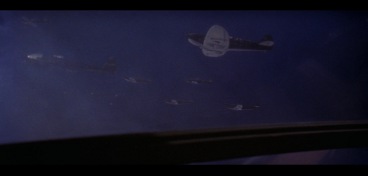
|
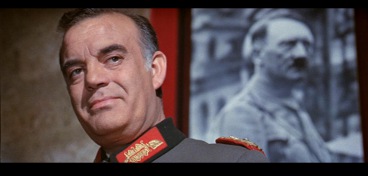
|
Frederick Stafford is well cast in the lead role (even if it might have been just because he looks like Christopher Plummer), his Austrian accent somewhat explained away by the script making him of Hungarian descent, however American war movie veteran Van Johnson may look the part as the RAF Air Marshall, but no attempt is made to hide or explain his distinct American drawl which just seems completely incongruous. Regular Spaghetti Western villain Luigi Pistilli gives a good performance as the head of the German spies and Western fans will recognise Corbucci regular Eduardo Fajardo in a brief role as a senior German commander.
Director Enzo G. Castellari would go on to make one of the most action packed war films ever made in Inglorious Bastards (1978), but fans of that film hoping for more of the same will certainly be disappointed. Instead, Eagles Over London is an exceedingly overambitious attempt to slavishly copy Battle of Britain on a minimal budget that would probably have been far more enjoyable if they had completely excised the flying scenes and focused on the ground-based action. Certainly of interest to genre and Castellari fans, but general war movie collectors will probably not enjoy this far from historical film.
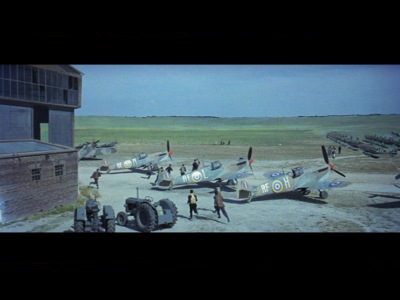
|

|
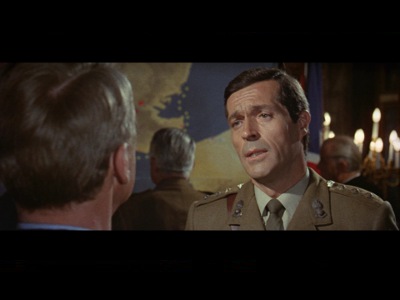
|
| Anyone famous in it? | Frederick Stafford - Austrian actor, best known for his leading role in Hitchcock's Topaz (1969) Van Johnson - an American actor and war movie regular, including a lead role in The Caine Mutiny (1954) Luigi Pistilli - Italian character actor who appeared in a number of Westerns including Da uomo a uomo (1967) |
| Directed by anyone interesting? | Enzo G. Castellari - best known for helming Inglorious Bastards (1978) he cut his teeth working on Westerns like Any Gun Can Play (1967) and Johnny Hamlet (1968). |
| Any gore or violence ? | A little blood. |
| Any sex or nudity? | None. |
| Who is it for? | Of interest to Italian exploitation war movie fans, but certainly not recommended to general war film collectors. |
| Visuals | Original Aspect Ratio - 2.35:1 anamorphic widescreen. Colour. 1080p HD The print is well transfered - retaining the original strong grain of Italian scope films from the era. |
| Audio | English Dolby stereo. |
| Subtitles | English - for the scenes in German |
| Extras | The disc includes:
|
| Region | Region ABC (ALL) |
| Other regions? | Released on DVD in the UK by Optimum with the same print and features. |
| Cuts? | Fully uncut. Print language is English. |